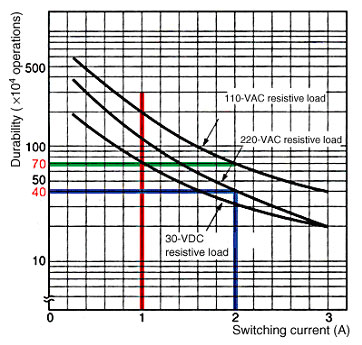How do you use the durability curve?
The durability curve is used to check the maximum switching capacity (expected service life).
The following example will be used to describe how to find the maximum switching capacity of a contact at a particular contact current.
Look at the graph to determine what is the expected service life of Relays with 1-A contact current and 20-VDC resistive load.
MY4 General-purpose Relays
1. Draw a vertical line where the switching current is 1 A (red line).
2. Draw a horizontal line from the point of intersection with the 30-VDC resistive load curve (green line).
3. Where the green line intersects with the durability axis is the expected service life. In this case, the expected number of operations is 700,000 operations.
Example:
What is the expected service life for a 220-VAC 2-A resistive load?
Answer:
Approximately 400,000 operations (blue line).